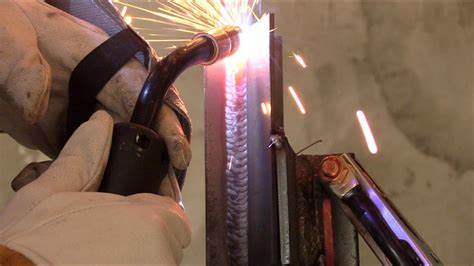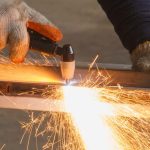Having the right kind of welder in your farm shop can save time and money on repairs and fabrication. The tried-and-true stick welder, while still useful, has paved the way for MIG welders and even TIG welders. All three have their place, as you’ll read in this article, and general techniques and safety precautions are important for any type of welding.
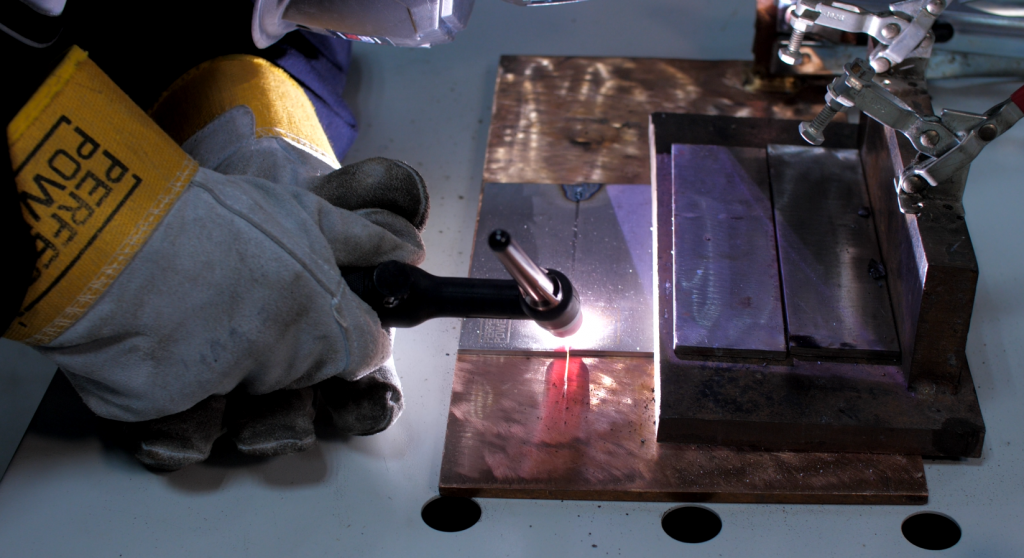
MIG Welding
6 Tips for Better MIG Welding Results
MIG (metal inert gas) welding, also known as FCAW (flux-cored arc welding), is the popular choice for many farmers because of its ability to produce clean welds on a variety of materials.
1. Properly Clean and Prepare Welding Surface
The number one failure of a MIG weld is porosity, and the most common cause of porosity is welding a dirty, oily, or painted surface. Contaminants become trapped in the weld, resulting in sponge-like holes. Other causes include inadequate shielding gas coverage or improper wire stickout.
“Farmers commonly fail to adequately prepare metal before welding,” says Miller Electric’s John Leisner. “This includes removing paint, rust, dirt, and other surface contaminants, and it also means grinding out cracks.”
Hydrogen is the worst weld-destroying impurity and is a particular challenge for welders because it’s found everywhere (think water, dirt, rust, paint, manure, grease). Careful cleaning can help mitigate hydrogen’s presence in your weld, giving you a stronger and more attractive finished project.
2. Check Your Ground
A welding arc requires a smooth flow of electricity through a circuit, and while electrical current flows through any available path, the majority will seek the path of least resistance. If your ground is not placed near the arc, the current may find another path, resulting in poor welder performance. Firmly attach the clamp to bare metal as near as possible to the arc.
If you’ve ever fired up your MIG welder and heard popping or crackling sounds, this could be due to a poor ground clamp, according to Jody Collier, welding educator at weldingtipsandtricks.com. Copper ground clamps are best, especially ones with strong springs. A good clamp makes for a good ground.
3. Pay Attention to Wire Stickout
Wire stickout is sometimes misunderstood. According to the American Welding Society (AWS), it refers to the distance from the end of the nozzle to where the wire melts off. As a general rule, the wire should stick out from the end of the gun’s contact tip between ¼ and 3/8 inch. Too much stickout softens the arc, making the weld pile up; however, in certain situations, such as welding thin sheet metal, a longer stickout is useful.
4. Match Your Technique to Your Metal
“Use both hands when possible,” Collier says. “Rest the crook of the gun neck in one hand and hold the part with the trigger in the other hand.” He recommends heat-resistant, heavy welding gloves for protection.
The most common method is to push the gun toward the direction of the weld, known as the forehand method. Forehand welding produces shallow penetration with a flat, wide, smooth surface. The backhand method – pulling the gun toward you – produces a deep-penetration weld that is narrow and high in the center. The best method to use is determined by the thickness of your metal and how deeply the weld needs to penetrate.
When making out-of-position welds (vertically, horizontally, or overhead), use the smallest possible wire diameter size and keep the weld pool small.
Take a look at your finished welding bead. A convex shape or rope-like bead often indicates your setting is too cold for the thickness of the repair and there isn’t enough heat being produced to penetrate the base metal. A concave shape bead can indicate too-high voltage, too-slow wire feed speed, or too-fast travel speed.
5. Keep Equipment Clean and Check Settings
Make sure to match drive rolls, gun cable liners, and contact tips to the wire size you’re using. Trying to run .030-diameter wire through .035 rolls will have you constantly changing feed speed and never getting the setting right, as the grooves on the rolls are too large. The same goes for the gun cable liner and contact tip sizes.
Clean the gun liner and drive rolls occasionally, and keep the gun nozzle clear of spatter. Replace the contact tip regularly, because worn tips can lead to an erratic arc, Collier says. If a tip enters the molten weld pool, replace it immediately.
Over time, gun liners can become clogged with dust and copper from the wire. You can check the liner for feeding issues by turning off the machine, undoing the spring clamp tensioner on the rollers, and laying the gun lead on the floor, with the contact tip removed. You should be able to push the wire through without having to force it; if not, replace it. New liners are inexpensive and make a noticeable difference.
Your welder should produce a steady buzz while welding. Hissing can indicate your voltage setting is too high, says Miller Electric’s Leisner. A loud, raspy sound can indicate the voltage is too low, while a constantly changing pitch or volume can indicate too long of a wire stickout.
6. Take Steps for Safety
A good auto-darkening helmet can make a huge difference in your final output. Moving even ¼ inch off the welding track when you nod your helmet down can screw things up. With a quality auto-darkening helmet, you can see where your wire is pointing before you pull the trigger. Leather footwear along with flame-resistant clothing without cuffs or open collars are recommended to prevent burns, or places where sparks can hide and smolder.
If you must use an extension cord, use the shortest length and biggest diameter possible.
Ensure your welding equipment is on a flat surface away from flammable materials, including paper, cloth, rags, oil, and gasoline. Avoid working in damp or wet conditions. Keep the work area free from clutter and keep necessary tools nearby. Never pick up hot metal with your hands, even when wearing gloves – use pliers.
Make sure your shop area is well ventilated to protect you from fumes, dust, and particles created during welding. You can use a fan to help pull fumes away from your breathing area.
MIG Gas Selection Tips
For MIG welding, an economic and efficient choice of gas is 100% carbon dioxide (CO2). However, when welding thin metal, CO2 may be too hot. Welding educator Collier suggests a mixture of 75% argon and 25% CO2 instead.
There are other shielding gas mixtures, and for certain uses it may make sense to invest in something more expensive:
- 75% argon and 25% CO2 for nice-looking welds (100% CO2 produces a lot of spatter) and for welding at high amperages.
- 85% argon and 15% CO2 for welding heavier-plate steel or for using on metal with considerable mill scale or rust.
- 90% argon and 10% CO2 for spray transfer welding and for heavy or thick sections of metal.
- 100% argon or an argon/helium mixture for welding aluminum.
- 98% argon and 2% CO2 for welding stainless steel.
For most farm shop needs, on-hand gas supplies should include CO2 and an argon-CO2 mixture.
MIG Wire Selection Tips
Although the most common welding wire diameters are .035 and .045 inch, a smaller- diameter wire can make it easier to create a good weld. Try an .025-inch wire diameter when welding material of ⅛ inch or less. A smaller-diameter wire produces more stable welds at a lower current, which has less tendency to burn through.
While a lower current and smaller wire can mean greater success on thinner materials, be careful using that approach on materials 3/16 inch or thicker because a .025-inch wire may cause lack of fusion.
Aluminum Welding Tips
More ag equipment is incorporating aluminum, forcing the issue of needing to make repairs to the metal. Any wire welder can handle aluminum, and the process is fairly easy to learn, according to Lincoln Electric. Keep in mind these aluminum welding tips:
- Buy U-groove drive rolls that support the wire without crushing it. Keep drive-roll adjustment on the loose side.
- Replace the cable lining using a Teflon, nylon, or similar liner product.
- Use only argon or argon-helium gas.
- Select an aluminum filler wire that is 3/64 inch or 1/16 inch in diameter. These larger wires are easier to feed down the gun cable.
- Employ a contact tip approximately .0015 inch larger than the diameter of the wire.
- Remove grease, oil, manure, and dirt by using an organic solvent such as acetone, a mild alkaline solution such as strong soap, or a citrus-based degreaser. Avoid strong alkaline or acid cleaners.
- Brush the repair using a new stainless-steel wire brush (only used for aluminum welding jobs) to remove the oxidized aluminum that occurs naturally on the surface of the metal. Aluminum oxides melt at 3,700°F, while the base metal melts at 1,200°F. Oxides on the repair surface inhibit penetration of the filler metal.
- Preheat the repair to no higher than 230°F to minimize cracking. Place tack welds at the beginning and end of the repair to aid in preheating and to prevent distortion.
- Use a short gun and a straight cable. If you are doing a lot of aluminum welding, consider buying a spool gun.
- Push into the weld to reduce contamination and to improve shield gas coverage.
- Weld hot and fast using higher amperage and voltage settings and faster weld-travel speeds to prevent burn-through.
- Fill the weld crater at the end of a weld. Craters are the leading reason aluminum welds crack. To fill the crater, continue to feed wire at the end of a weld, reversing your direction of travel back over the weld for about 1 inch.
- If you aren’t welding the repair site immediately after cleaning, cover the welding joint with brown kraft paper to prevent dirt and grit from the air from settling into the weld area.
Stick Welding Still Has Its Place
The popularity of wire welders has relegated many stick welders to the shop corner to collect dust, but these machines still have a place on the farm.
The modern stick welder can utilize both alternating current (AC) and direct current (DC), providing advantages such as easier starts, less sticking, less spatter, more attractive welds, and easier vertical and overhead welding.
Stick welding also produces deeper welds; excels in outdoor operations, where wind can blow away MIG shielding gas; works well on thick metals; and burns through rust, dirt, and paint. These welders are also portable and simple to operate.
Tips for stick welding:
- An all-purpose go-to electrode is an E6011, which provides a deep-penetrating weld even in dirty, rusty, or painted materials. But keep some E7018s around, as these low-hydrogen electrodes are ideal for out-of-position welding and when welding on high-strength steel. If you weld stainless steel, opt for a 312 Plus electrode.
- To set your amperage, first determine the recommended range for your electrode type and diameter. Then pick an amperage within the range based on your metal thickness. (Thinner metals take fewer amps.)
- Practice scratch-start and tapping techniques to see which one works for you. With the scratch start, you drag the electrode across the workpiece quickly like striking a match, lifting the electrode slightly after touching the work. If the arc goes out, then the electrode was lifted too high. If the electrode sticks to the workpiece, use a quick twist to free it. With the tapping technique, bring the electrode straight down on the workpiece and then lift slightly to start the arc. If the arc goes out, you’ve lifted the electrode too high. Again, twist to free the electrode if it sticks.
- When welding a fillet, the leg of the weld should be equal to the thickness of the parts welded.
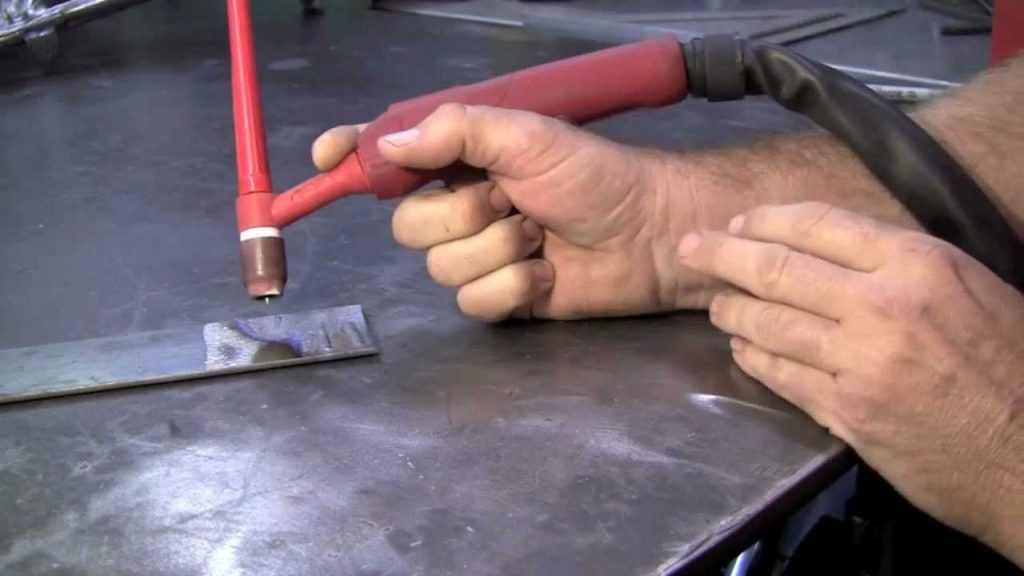
TIG Best Practices
Once only dreamed about by farmers wanting a better way to weld thin metal, aluminum, and stainless steel, TIG (tungsten inert gas) welders are becoming more common in farm shops.
TIG requires three-way coordination using both hands (one holding the heat source in a tungsten electrode and the other hand feeding fill rod into the arc) and a foot (operating a pedal or torch-mounted amperage control for starting, adjusting, and stopping the flow of current).
Miller Electric offers these tips for TIG welding success:
- Make sure everything is very clean. TIG welding tolerates no contaminants. Be sure to clean your base metal with a good degreaser then scrub it with a dedicated wire brush. (Do not use the same brush on different kinds of metal). Wipe down the filler rod with degreaser too.
- Get comfortable. It’s nice to be seated while welding. If sitting isn’t possible, any small adjustments to stance or body position that make you more comfortable have noticeable effects on the weld.
- Look for ways to support your hands. Having good support for your hands and arms is crucial for moving the torch with precise control. Often you can rest your wrists on the part being welded. You also can support and rest your torch hand on small wood or metal blocks.
- Do a practice run without power. Many professional welders do this before every pass. Get into the most comfortable position and run your hands along the path they will travel as you make the weld. You often find that a slight adjustment of your position allows you to make a longer pass, or to move your hands more comfortably.
- Every welder contaminates the electrode at some point, but it’s essential that you replace a contaminated electrode right away. Consider keeping a supply of pre-sharpened electrodes near your welding bench so you can swap them out without a trip to the grinder.
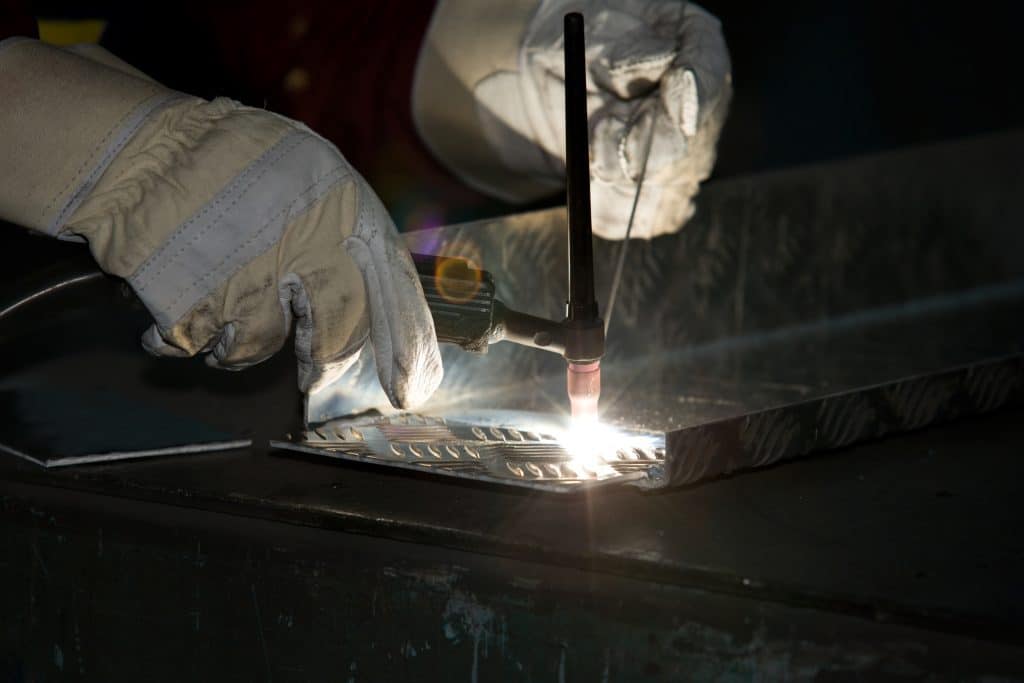
General Welding Tips
Rules on Angle, Direction, Speed, and Position
Even novice welders can experience some success, but a few hard-and-fast rules can produce lasting welding repairs.
- Push or pull: Leisner of Miller Electric says, “If it produces slag, you drag.” Or in other words, drag the rod or wire when stick or flux-core welding. Push the wire when MIG welding.
- Work angle: With wire welding, hold the gun at a 10° to 15° angle in the direction you push the weld. With stick welding, maintain a 20° to 30° lead angle in the dragging direction. With a fillet weld, regardless of welding process, hold the rod or wire at a 45° angle between the two pieces of metal.
- Arc spacing: Adjust travel speed so the welding arc stays within the leading one-third of the weld pool. For wire (flux-core or MIG) welding, keep a work distance of ⅜ inch to ½ inch. With stick welding, look to keep that distance ⅛ inch between the rod tip and workpiece. The arc length should not exceed the diameter of the electrode core.
- Speed: Watch the welding puddle and ridge where the molten metal solidifies. When wire welding, the ridge should be approximately ⅜ inch behind the wire electrode. A too-slow travel speed produces a wide, convex bead with shallow penetration that also deposits too much metal. On the other hand, a too-high travel speed creates a shallow weld that produces a narrow and highly crowned bead. Most travel speeds for various joints are well below 40 inches per minute.
Gravity is your enemy when working out of position, so counteract its efforts (particularly when wire welding) by using a little less voltage and a lower wire-feed speed to create a smaller puddle. Reversing polarity to concentrate the heat at the electrode tip results in cooler welding, which lets the weld puddle cool faster to prevent dripping. Here are tips on welding out of position:
- Horizontal welds: Drop your work angle to 0° or 15° and then weld at a steady pace to keep the weld puddle in place.
- Vertical welds: On 3/16-inch and thinner steel, weld in a downward motion. However, this movement can be a challenge. The weld puddle can get ahead of the arc and become an insulator, reducing penetration. On 1/16-inch and thicker steel, weld in an upward motion, using a side-to-side technique, moving the arc from the right to the center and then to the left to create a triangle.
- Overhead welds: Lower the amperage and move quickly to keep the weld puddle narrow. Use a circular motion and a whip action to prevent the weld puddle from spilling away from the weld.
Why Do Welds Crack?
Welds can crack for one or more of the following reasons:
- Not grinding cracks out to their bottom prior to welding.
- Forming undersized beads. Welds should always be slightly wider than they are deep.
- Forming concave or hollow beads. Such welds can lead to cracking down the middle of the bead. Welds should always be convex or rounded up.
- Failing to properly clean a repair. Leaving rust, paint, grease, dirt, or moisture on a repair introduces hydrogen into the weld that can promote cracking.
- Not preheating prior to welding. This is particularly required when the steel you’re welding has a higher carbon or alloy content.
- Failure to use of low-hydrogen electrodes to repair hard-to-weld steels (high carbon or alloy content).
- Failing to fill craters at the end of a weld.
- Not properly reinforcing a weld repair.
- Not laying down a first bead on multiple pass welds that is of sufficient size and flat or convex. This resists cracking until the later beads can be added for support.
Rigid parts are more prone to cracking. If possible, weld toward the unrestrained end of such parts and leave a 1/32-inch gap between plates for free shrinkage movement as the weld cools. Peen each bead while it is still hot to relieve stress.
Sponge-like holes or tiny bubbles that appear on the surface of a weld are sure signs that your weld suffers from porosity, welding educator Collier says.
Weld porosity can take many forms, including surface pores, wormholes, crater pipes, and cavities that are seen (on the surface) and unseen (deep in a weld).
Beyond its ugly appearance, porosity predicts a poor, weak weld.
Possible causes of porosity include:
- Inadequate shielding gas coverage, resulting from improper flow rate or from a draft blowing away the gas. Typical gas flow should be about 30 to 40 cubic feet per hour. Invest in a flow meter to properly set flow and pressure.
- Lubricants, moisture, rust, paint, mill scale, and other contaminants on the base material.
- Excessive wire stickout, which prevents proper shielding gas coverage.
- Not following the wire manufacturer’s recommended wire stickout.
Keep the puddle molten for a longer time to allow gases to boil out of the weld before it freezes.
If you must weld in a location where you can’t prep the surface well, or on a high stress point, reinforcing your weld is important. Reinforcement is also needed if a piece has broken more than once in or near the same place as a previous repair.
Be sure to bevel edges at a 30° angle where the new metal meets the old metal. Doing so provides better welding penetration.
For heavier sections of material, leave a small space at the bottom of the joint. To do this, first bevel the edges and then grind along the bottom of the bevel until it’s the thickness of a nickel.
Material over ¼ inch thick should usually be welded in multiple passes.






